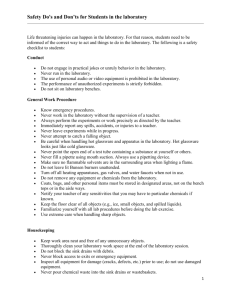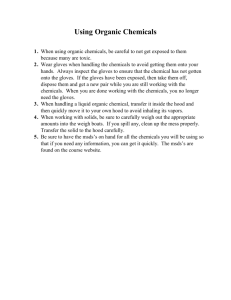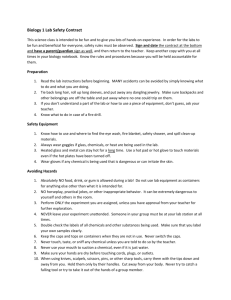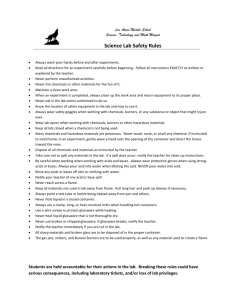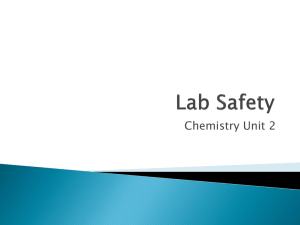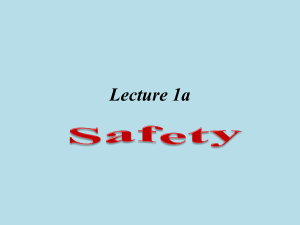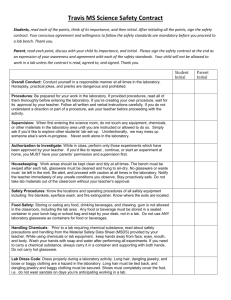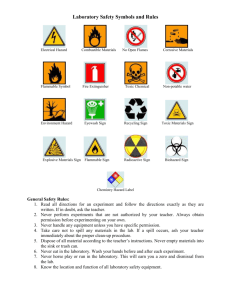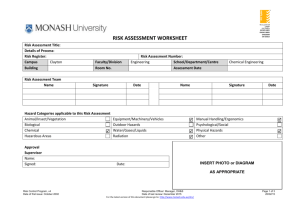Student Guidelines - TSA
advertisement
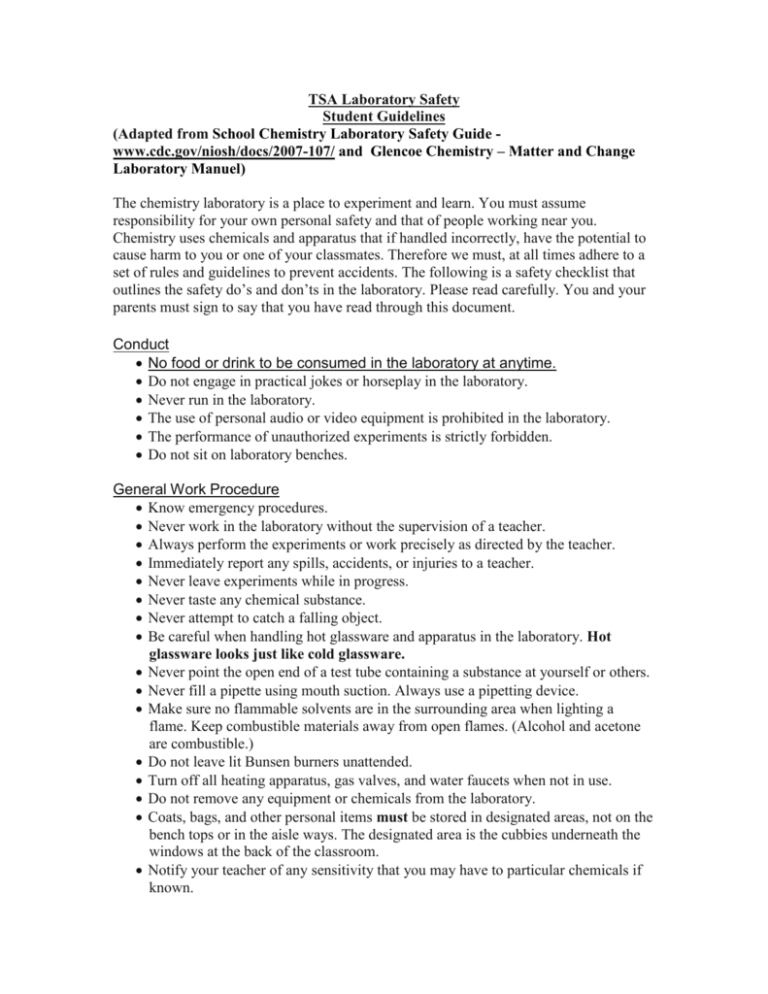
TSA Laboratory Safety Student Guidelines (Adapted from School Chemistry Laboratory Safety Guide www.cdc.gov/niosh/docs/2007-107/ and Glencoe Chemistry – Matter and Change Laboratory Manuel) The chemistry laboratory is a place to experiment and learn. You must assume responsibility for your own personal safety and that of people working near you. Chemistry uses chemicals and apparatus that if handled incorrectly, have the potential to cause harm to you or one of your classmates. Therefore we must, at all times adhere to a set of rules and guidelines to prevent accidents. The following is a safety checklist that outlines the safety do’s and don’ts in the laboratory. Please read carefully. You and your parents must sign to say that you have read through this document. Conduct No food or drink to be consumed in the laboratory at anytime. Do not engage in practical jokes or horseplay in the laboratory. Never run in the laboratory. The use of personal audio or video equipment is prohibited in the laboratory. The performance of unauthorized experiments is strictly forbidden. Do not sit on laboratory benches. General Work Procedure Know emergency procedures. Never work in the laboratory without the supervision of a teacher. Always perform the experiments or work precisely as directed by the teacher. Immediately report any spills, accidents, or injuries to a teacher. Never leave experiments while in progress. Never taste any chemical substance. Never attempt to catch a falling object. Be careful when handling hot glassware and apparatus in the laboratory. Hot glassware looks just like cold glassware. Never point the open end of a test tube containing a substance at yourself or others. Never fill a pipette using mouth suction. Always use a pipetting device. Make sure no flammable solvents are in the surrounding area when lighting a flame. Keep combustible materials away from open flames. (Alcohol and acetone are combustible.) Do not leave lit Bunsen burners unattended. Turn off all heating apparatus, gas valves, and water faucets when not in use. Do not remove any equipment or chemicals from the laboratory. Coats, bags, and other personal items must be stored in designated areas, not on the bench tops or in the aisle ways. The designated area is the cubbies underneath the windows at the back of the classroom. Notify your teacher of any sensitivity that you may have to particular chemicals if known. Keep the floor clear of all objects (e.g., ice, small objects, spilled liquids). Report any accident, injury, incorrect procedure, or damaged equipment immediately to your teacher. In The Classroom Study your lab activity before you come to the lab. If you are in doubt about procedures, ask your teacher for help. Keep work area neat and free of any unnecessary objects – including and binders and textbooks. Thoroughly clean your laboratory work space at the end of the laboratory session. Wash and stack all glassware, turn off hotplates, return apparatus and wipe down lab bench. Do not block the sink drains with debris. Never block access to exits or emergency equipment. Inspect all equipment for damage (cracks, defects, etc.) prior to use; do not use damaged equipment. Never pour chemical waste into the sink drains or wastebaskets. Place chemical waste in appropriately labeled waste containers. Ask the teacher if you are unsure. Properly dispose of broken glassware and other sharp objects (e.g., syringe needles) immediately in designated containers. The broken glass and sharps container is located under the sinks. Properly dispose of weigh trays, weigh paper, gloves, filter paper, and paper towels in the laboratory. Apparel in the Laboratory Always wear appropriate eye protection (i.e., chemical splash goggles) in the laboratory. Wear disposable gloves, as provided in the laboratory, when handling hazardous materials. Remove the gloves before exiting the laboratory. Wear a full-length, long-sleeved laboratory coat or chemical-resistant apron. Wear shoes that adequately cover the whole foot; low-heeled shoes with non-slip soles are preferable. Do not wear sandals, open-toed shoes, open- backed shoes, or high-heeled shoes in the laboratory. Avoid wearing shirts exposing the torso, shorts, or short skirts; long pants that completely cover the legs are preferable. Secure long hair and loose clothing (especially loose long sleeves, neck ties, or scarves). Remove jewelry (especially dangling jewelry). Contact lenses should not be worn in the lab, even if goggles are worn. Lenses can absorb vapors and are difficult to remover in an emergency. Synthetic fingernails are not recommended in the laboratory; they are made of extremely flammable polymers, which can burn to completion and are not easily extinguished. Hygiene Practices Keep your hands away from your face, eyes, nose, mouth, and body while using chemicals. Food and drink, open or closed, should never be brought into the laboratory or chemical storage area. Never use laboratory glassware for eating or drinking purposes. Do not apply cosmetics while in the laboratory or storage area. Wash hands after removing gloves, and before leaving the laboratory. Remove any protective equipment (i.e., gloves, lab coat or apron, chemical splash goggles) before leaving the laboratory. Emergency Procedure Know the location of all the exits in the laboratory and building. Know the location of the emergency phone. Know the location of and know how to operate the following: − Fire extinguishers (next to door) − Alarm systems with pull stations − Fire blankets (on wall next to sink) − Eye washes (next to sink) − First-aid kits − Absorption and neutralization material In case of an emergency or accident, follow the established emergency plan as explained by the teacher and evacuate the building via the nearest exit. Chemical Handling Check the label to verify it is the correct substance before using it. Wear appropriate chemical resistant gloves before handling chemicals. o Note - Gloves are not universally protective against all chemicals. Always use a spatula to remove solid reagent from a container. Do not directly touch any chemical with your hands. Never use a metal spatula when working with peroxides. Metals will decompose explosively with peroxides. Hold containers away from the body when transferring a chemical or solution from one container to another. Use a hot water bath to heat flammable liquids. Never heat directly with a flame. Never light a match or burner without permission. Add concentrated acid to water slowly. Never add water to a concentrated acid. Weigh out or remove only the amount of chemical you will need. Do not return the excess to its original container, but properly dispose of it in the appropriate waste container. Keep the balance or scale area clean. Never weigh chemicals directly on the pan of the balance or scale, use weigh paper and weigh trays. Never touch, taste, or smell any reagents. Never place the container directly under your nose and inhale the vapors. Never mix or use chemicals not called for in the laboratory exercise. Use the laboratory chemical hood, if available, when there is a possibility of release of toxic chemical vapors, dust, or gases. When using a hood, the sash opening should be kept at a minimum to protect the user and to ensure efficient operation of the hood. Keep your head and body outside of the hood face. Chemicals and equipment should be placed at least six inches within the hood to ensure proper airflow. Clean up all spills properly and promptly as instructed by the teacher. Dispose of chemicals as instructed by the teacher. When transporting chemicals (especially250mL or more), place them in a secondary container or bucket (rubber, metal or plastic) designed to be carried and large enough to hold the entire con- tents of the chemical. Never handle bottles that are wet or too heavy for you. Use equipment (glassware, Bunsen burner, etc.) in the correct way, as indicated by the teacher.
